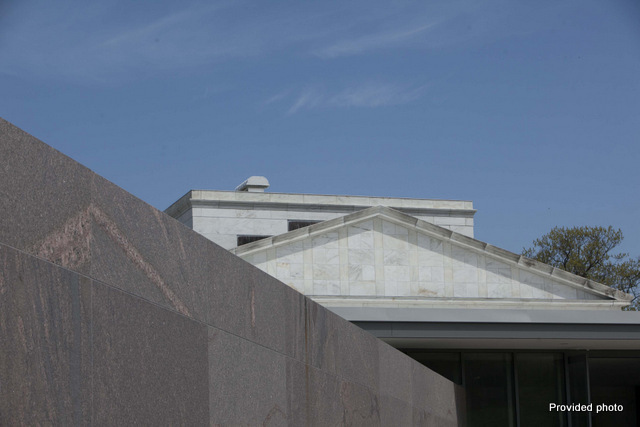Clark Art's Evolution Continues With July 4 Reopening
 The old Clark meets the new Clark at the intersection of Tadao Ando's Clark Center, foreground, and the 1955 'white building.' The old Clark meets the new Clark at the intersection of Tadao Ando's Clark Center, foreground, and the 1955 'white building.' |
WILLIAMSTOWN, Mass. — The physical expansion of the Clark Art Institute makes its public debut on Friday.
But it is only the next step in a philosophical expansion that began six years ago.
The Clark built its reputation on the works by old masters and Impressionists that drew the eye of founders Sterling and Francine Clark.
But at the turn of the 21st century, the Clark began implementing a master plan that envisioned a place at the museum for works from the 20th century and beyond.
"Our future was already suggested programmatically in 2008 when we started to do late 20th century exhibitions and things like that at the Stone Hill Center," Clark Director Michael Conforti said last week. "We were testing, I would say, the opportunity to do masters of the 20th century."
Friday at 1 p.m., the Clark will open to the public a renovated 1955 "white building," home to the permanent collection, and the brand new Clark Center. The a 42,560 square-foot, two-story structure includes a cafe and dining area, museum shop, conference space, an outdoor terrace and — most importantly to the Clark's new mission — more than 11,000 square feet of special exhibition space.
Together with the 2,800 square feet of exhibition space at the recently renamed Lunder Center at Stone Hill, the Clark now has nearly 14,000 square feet to devote to the kinds of art that the Clarks — Sterling and Francine — never would have seen coming.
Next month, the Clark Center's downstairs gallery opens with an exhibition of abstract expressionist paintings on loan from the National Gallery of Art.
"We were anxious to take the 20th century broadly and put that into our exhibition mission," Conforti said. "We were doing that because audiences are interested. And we have a teaching responsibility. Curators and and future directors still come through here and train at the Clark and at Williams [College].
"We need to make sure that we provided those kinds of exhibition opportunities for people."
And like any museum, the Clark needed to evolve.
Up the road in Vermont, the Bennington Museum took a similar — if more modest — step last year when it added a gallery devoted to modern art created by internationally known artists with ties to the southwestern Vermont town.
The curator spearheading the Bennington Modernism gallery said institutions like the Clark or the Bennington Museum cannot afford to be too narrow in their programming.
"I think the museum community at large is taking a look at itself," Jamie Franklin said. "Museums are always trying to broaden their constituency.
"We have people who are coming through to see Grandma Moses and early American folk art. And they come here and see this, and it's great. But then there are other people who may not be interested in Grandma Moses and folk art, but they are interested in mid-20th century abstract avante garde art, and they come here to see this.
"Though this may not be what people think of when they think of the Bennington Museum, it's not outside of our mission at all."
Franklin said that the Bennington Museum has been pleased with the reaction to Bennington Modernism.
"As people come here who are expecting the things you'd expect from the Bennington Museum ... you expect them to walk into this room and say, 'Oh, abstract art. That's not for me,' and walk away," Franklin said. "But I think this work is really engaging.
"Children, in particular, have been really, really loving this exhibit. Deena Malloy, our education and programs coordinator, has been working with children exploring abstract art and what it's about and what it means. And kids really get it.
"And I think our general public really gets it."
In North Berkshire, audiences who "get" modern art have traditionally gravitated toward the Massachusetts Museum of Contemporary Art in North Adams. Conforti said the Clark's expansion into modernism links the 19th century paintings at the Clark with the contemporary artists down the road.
"This brings us more up-to-date and complements the other cultural institutions here, in particular our partner Mass MoCA, because there's a bridge between what we used to do in old masters and the 19th century and what they do in terms of contemporary, emerging artists," Conforti said in an interview on the Clark Center terrace.
"There's no greater partnership anywhere in the country than the partnership between the Williams College Museum of Art, the Clark and Mass MoCA. ... We don't know how many and different the collaborations might be in the future — made possibe by this special physical space."
Tags: Clark Art,
 The old Clark meets the new Clark at the intersection of Tadao Ando's Clark Center, foreground, and the 1955 'white building.'
The old Clark meets the new Clark at the intersection of Tadao Ando's Clark Center, foreground, and the 1955 'white building.' The old Clark meets the new Clark at the intersection of Tadao Ando's Clark Center, foreground, and the 1955 'white building.'
The old Clark meets the new Clark at the intersection of Tadao Ando's Clark Center, foreground, and the 1955 'white building.'